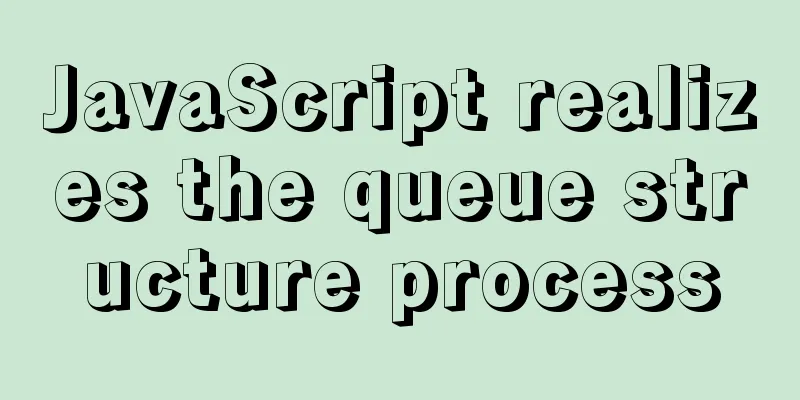JavaScript realizes the queue structure process

1. Understanding Queues The previous blog has talked about the restricted data structure - the stack. Now, let’s take a look at the
Its structure diagram can be expressed as:
2. Encapsulation QueueThe queue structure is also implemented in an array format. First, create a class.
function Queue(){
}
Add properties and methods inside it, and add the array to the class through the property methods. Then use the prototype method to add commonly used operations. Common operations on queues are:
Now let’s implement it:
function Queue(){
this.items = [];
//Add one (or more) new items to the end of the queue enqueue()
Queue.prototype.enqueue = function(element){
this.items.push(element);
}
//Remove the first item in the queue (i.e. the front item in the queue) dequeue()
Queue.prototype.dequeue = function(){
return this.items.shift();
}
//Return the first element in the queue front()
Queue.prototype.front = function() {
return this.items[0];
}
// Check if the stack is empty isEmpty()
Queue.prototype.isEmpty = function(){
return this.items.length == 0;
}
//Return the number of elements contained in the queue size()
Queue.prototype.size = function(){
return this.items.length;
}
//Convert the contents of the queue into a string form toString()
Queue.prototype.toString = function(){
var str = '';
for(var i =0;i<this.items.length;i++){
str += this.items[i] + ' ';
}
return str;
}
}
The above is the encapsulation of the queue, now verify it:
var queue = new Queue();
queue.enqueue(10);
queue.enqueue(20);
queue.enqueue(30);
queue.enqueue(40);
queue.enqueue(50);
console.log(queue);
console.log('The first item removed is: ' + queue.dequeue());
console.log('The first element in the queue is: ' + queue.front());
console.log('Is the stack empty: '+queue.isEmpty());
console.log('The contents of the stack structure are:');
console.log(queue.toString());
The output is:
Build successful. Let’s take a look at a case of passing the parcel while beating the drum! 3. The Case of Passing the Flower by Beating the DrumOriginal game rules:
Modify the game rules:
Encapsulate a queue-based function:
The code is as follows:
// Encapsulate queue function Queue(){
this.items = [];
//Add elements at the end Queue.prototype.enqueue = function(element){
this.items.push(element);
}
//Remove the first element Queue.prototype.dequeue = function(){
return this.items.shift();
}
//Return the first element Queue.prototype.front = function(){
return this.items[0];
}
//Return the number of elements contained in the queue Queue.prototype.size = function(){
return this.items.length;
}
}
function passGame(nameList,num){
// Create a queue var queue = new Queue();
//Add all people to the queue for(var i = 0;i<nameList.length;i++){
queue.enqueue(nameList[i]);
}
//Play the game while (queue.size() > 1) {
//The people before num are added to the end of the queue for(var i =1;i<num;i++){
queue.enqueue(queue.dequeue());
}
//People with num numbers are directly removed from queue.dequeue();
}
//Get the winner information var endName = queue.front();
console.log('The remaining people are:' + endName);
return nameList.indexOf(endName);
}
//Test var nameList = ['a','b','c','d','e'];
var g = passGame(nameList,5);
console.log('This person's location is: '+g);
The output is:
This is the end of this article about the process of implementing queue structure in JavaScript. For more relevant content about implementing queue structure in JavaScript, please search previous articles on 123WORDPRESS.COM or continue to browse the following related articles. I hope you will support 123WORDPRESS.COM in the future! You may also be interested in:
|
<<: How to do a good refactoring is not only refactoring the code but also refactoring life
>>: Introduction to basic concepts and technologies used in Web development
Recommend
Detailed explanation of how MySQL determines whether an InnoDB table is an independent tablespace or a shared tablespace
Preface InnoDB stores data in tablespaces. In the...
A brief talk about calculated properties and property listening in Vue
Table of contents 1. Computed properties Syntax: ...
Linux /etc/network/interfaces configuration interface method
The /etc/network/interfaces file in Linux is used...
How to quickly install Nginx in Linux
Table of contents What is nginx 1. Download the r...
VMware Workstation is not compatible with Device/Credential Guard
When installing a virtual machine, a prompt appea...
Detailed tutorial for installing mysql5.7.21 under Windows system
MySQL Installer provides an easy-to-use, wizard-b...
Implementation of k8s deployment of docker container
Environment: (docker, k8s cluster), continue with...
Jenkins packaging microservices to build Docker images and run them
Table of contents Environment Preparation start 1...
Steps to enable MySQL database monitoring binlog
Preface We often need to do something based on so...
CSS new feature contain controls page redrawing and rearrangement issues
Before introducing the new CSS property contain, ...
How to center the entire page content so that the height can adapt to the content and automatically expand
How to center the entire page content and how to m...
Example of implementing bidirectional messaging between parent and child pages in HTML iframe
One day, the leader put forward a requirement to ...
Vue implements real-time refresh of the time display in the upper right corner
This article example shares the specific code of ...
How InnoDB cleverly implements transaction isolation levels
Preface In the previous article Detailed Explanat...
Summary of ways to implement single sign-on in Vue
The project has been suspended recently, and the ...












